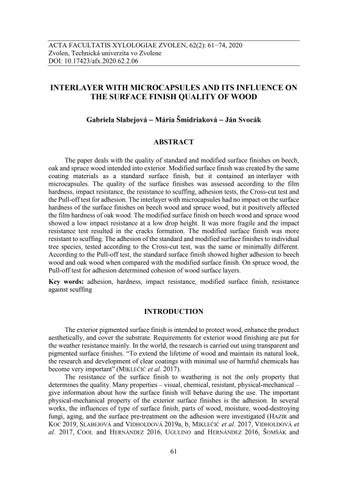ACTA FACULTATIS XYLOLOGIAE ZVOLEN, 62(2): 61−74, 2020 Zvolen, Technická univerzita vo Zvolene DOI: 10.17423/afx.2020.62.2.06
INTERLAYER WITH MICROCAPSULES AND ITS INFLUENCE ON THE SURFACE FINISH QUALITY OF WOOD Gabriela Slabejová Mária Šmidriaková Ján Svocák ABSTRACT The paper deals with the quality of standard and modified surface finishes on beech, oak and spruce wood intended into exterior. Modified surface finish was created by the same coating materials as a standard surface finish, but it contained an interlayer with microcapsules. The quality of the surface finishes was assessed according to the film hardness, impact resistance, the resistance to scuffing, adhesion tests, the Cross-cut test and the Pull-off test for adhesion. The interlayer with microcapsules had no impact on the surface hardness of the surface finishes on beech wood and spruce wood, but it positively affected the film hardness of oak wood. The modified surface finish on beech wood and spruce wood showed a low impact resistance at a low drop height. It was more fragile and the impact resistance test resulted in the cracks formation. The modified surface finish was more resistant to scuffing. The adhesion of the standard and modified surface finishes to individual tree species, tested according to the Cross-cut test, was the same or minimally different. According to the Pull-off test, the standard surface finish showed higher adhesion to beech wood and oak wood when compared with the modified surface finish. On spruce wood, the Pull-off test for adhesion determined cohesion of wood surface layers. Key words: adhesion, hardness, impact resistance, modified surface finish, resistance against scuffing
INTRODUCTION The exterior pigmented surface finish is intended to protect wood, enhance the product aesthetically, and cover the substrate. Requirements for exterior wood finishing are put for the weather resistance mainly. In the world, the research is carried out using transparent and pigmented surface finishes. “To extend the lifetime of wood and maintain its natural look, the research and development of clear coatings with minimal use of harmful chemicals has become very important” (MIKLEČIĆ et al. 2017). The resistance of the surface finish to weathering is not the only property that determines the quality. Many properties – visual, chemical, resistant, physical-mechanical – give information about how the surface finish will behave during the use. The important physical-mechanical property of the exterior surface finishes is the adhesion. In several works, the influences of type of surface finish, parts of wood, moisture, wood-destroying fungi, aging, and the surface pre-treatment on the adhesion were investigated (HAZIR and KOC 2019, SLABEJOVÁ and VIDHOLDOVÁ 2019a, b, MIKLEČIĆ et al. 2017, VIDHOLDOVÁ et al. 2017, COOL and HERNÁNDEZ 2016, UGULINO and HERNÁNDEZ 2016, ŠOMŠÁK and 61
















